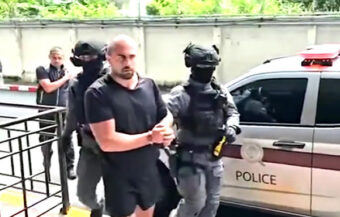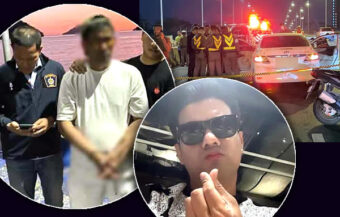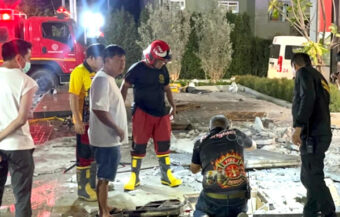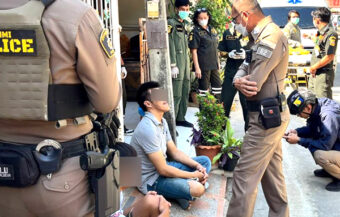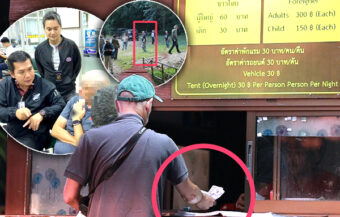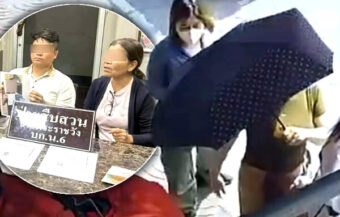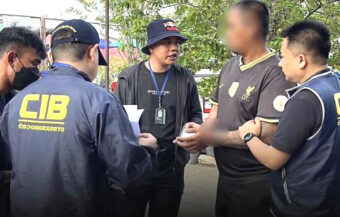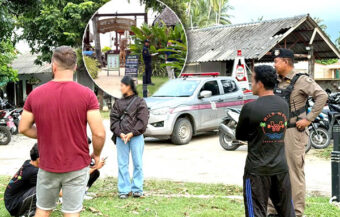Bangkok narrowly escapes disaster as a massive sinkhole opens near Vajira Hospital and Samsen Police Station, swallowing road and vehicles. Officials link it to subway tunnel work, sparking urgent emergency response and alarm over safety and infrastructure risks.
Bangkok had a narrow escape on Wednesday when a massive sinkhole opened near a hospital and police station—yet no lives were lost. The gaping wound in the city’s heart sent shockwaves across the capital and the world. By evening, officials pointed to underground construction as the likely cause, with a troubled section of tunnel linked to the new train line exposed at the bottom of the crater. Newly appointed Prime Minister Anutin Charnvirakul rushed to the scene just hours before his cabinet was sworn in at Dusit Palace. He returned early Thursday morning to oversee a frantic, high-stakes engineering operation aimed at stemming further collapse.
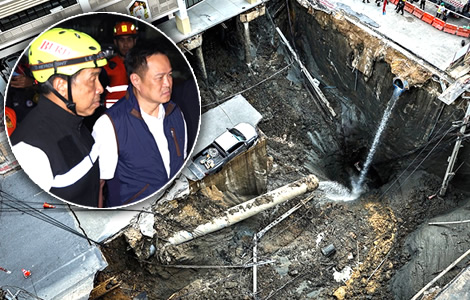
On the very day Thailand swore in a new government, the country made headlines for all the wrong reasons. While officials celebrated a political milestone, a massive sinkhole suddenly opened on Samsen Road, in the heart of Bangkok. The collapse occurred near Vajira Hospital and sent shockwaves across the city—both literally and politically.
The hole appeared without warning, ripping through the surface near a busy stretch of road. It happened close to Samsen Police Station and one of the entrances to the under-construction Purple Line subway, managed by the Mass Rapid Transit Authority of Thailand (MRTA). Almost immediately, chaos erupted.
Police vehicles were swallowed. Pavement crumbled. People ran for safety. Thankfully, there were no fatalities. However, the destruction was swift and terrifying.
Authorities quickly linked the disaster to construction work beneath the street. According to early findings, the sinkhole was caused by excavation for the MRTA’s Purple Line extension.
Authorities quickly link the massive Samsen Road sinkhole to new underground subway construction
Soil had reportedly begun to fall into a freshly dug underground tunnel. Photos taken at the scene showed gaping holes exposing deep layers of sand and broken concrete.
As the dust settled, blame became the next big question. Prime Minister Anutin Charnvirakul, whose family is connected to the project’s contractor, made a public appearance at the site. However, he cautioned against rushing to conclusions. According to him, it was too early to assign blame. Yet that didn’t stop the Bangkok Metropolitan Administration (BMA) from launching an aggressive emergency response.
BMA engineers moved fast. They closed off the area and began inspecting buildings near the crater. Vajira Hospital was partially evacuated. Samsen Police Station was also cleared, as officials feared its foundation piles had been undermined.
Meanwhile, surrounding structures were scanned for further signs of subsidence or risk of collapse. Heavy equipment was brought in, including a 200-ton crane to remove four massive concrete slabs that had fallen into the void.
At the same time, Governor Chadchart Sittipunt led ground operations. He ordered 50,000 sandbags to be deployed around the sinkhole. Their goal was to block water from seeping further into the tunnel and dragging more soil with it. However, the effort wasn’t fully successful. Concrete was later ordered after the sandbags failed to fully stop the collapse. Clearly, the soil was continuing to shift.
Machinery and sandbags used as engineers scrambled to stabilise the tunnel and prevent further collapse
Throughout Wednesday, officials tried to contain the growing disaster. Engineers warned that the structure beneath the street had been compromised. Significantly, the tunnel’s junction point—where the round tunnel meets the flat wall of the box structure—was identified as especially weak. Water had likely seeped through sharp vertical gaps, pulling sandy soil inward. As a result, the tunnel below began to act like a vacuum chamber.
While no lives were lost, the sense of danger was real. The entire Suan Oi community near Samsen Road was put on alert. Dozens of families were relocated to emergency shelters and nearby hotels. Water service was shut off in a large radius to reduce pressure on cracked mains. Electrical systems were also under threat as the ground beneath them shifted unpredictably.
By Thursday morning, the situation remained tense. Prime Minister Anutin returned to the site for a second inspection. This time, he appeared alongside Governor Chadchart, who had publicly dismissed rumours that leaking water pipes caused the collapse. Instead, he clarified that the pipes likely burst after the soil gave way—not before. The city, he said, was dealing with a classic case of soil subsidence driven by underground erosion.
The problem, officials noted, is not new. Bangkok has a long history of soil instability, especially during heavy rainfall or seismic activity. Just months earlier, an earthquake on March 28th had rocked the capital.
Past construction and ongoing subway work combine with groundwater pressure to open the huge sinkhole
That disaster led to the collapse of the Office of the Auditor-General building in Chatuchak and sent scores of engineers and officials to prison. Many fear this latest incident could follow a similar path—legally and politically. This time, though, the danger appears manmade.
While past engineering works decades ago—carried out by an American firm from Texas—had reshaped parts of the city’s underground, the immediate cause now seems linked to active subway construction. Experts believe that sandy backfill from earlier projects may have shifted into the newer tunnel. This movement, combined with water pressure, likely triggered the collapse.
As night fell, urgency grew. Crews worked nonstop to fill the void with crushed rock, concrete, and reinforcements. However, engineers remained concerned. Soil continued to slide through unseen channels. Concrete slabs had shifted.
The risk of further collapse lingered. Laser-based sensors were installed to monitor ground movement in real time. Teams surveyed nearby roads, especially Sukhothai Road, where weight restrictions were imposed. All heavy vehicles were immediately banned.
Engineers scramble to stabilise collapsing subway tunnel while nearby buildings show signs of damage and risk
Foundation inspections also continued at Vajira Hospital and other nearby buildings. Low-rise structures showed signs of destabilisation. Piles beneath several properties were cracked or dislodged.
Meanwhile, the MRTA’s contractor, CKST-PL JV, was ordered to accelerate repairs. They were instructed to seal leaks, reinforce walls, and prevent additional erosion. Still, as of Thursday morning, large gaps remained. Water continued to seep inward, carving out the soft soil beneath.
The estimated size of the collapse was staggering. Over 10,000 cubic meters of soil may have been lost. The tunnel is 15–16 meters below ground, and engineers believe that much of the void now stretches to that depth. Essentially, the street is sitting atop a cavity the size of a small football field.
On-site, the tunnel’s structural flaw became clearer. Its intersection with a flat wall had formed a weakness. As pressure from groundwater built up, the area buckled. Sand and earth, loosened by rain and vibration, simply flowed in. The tunnel was wide open.
Engineers monitor collapsing tunnel as concrete slabs shift and soil loss threatens further structural instability
Despite reassurances, public anger began to grow. Many citizens are demanding accountability. If the MRTA or its contractor is found to have ignored soil reports or safety protocols, legal action could follow. The Prime Minister acknowledged this publicly, stating that both civil and criminal liability would be examined once the emergency is under control.
Even as the government worked to calm nerves, more concerns surfaced. What if it rains again, and what if nearby tunnels are also compromised? What if the ground shifts further? For now, no one has the answers. But engineers are racing against time to stabilise the site.
Worst Earthquake tremors to hit Bangkok in nearly 70 years with at least 4 people dead. Toll may rise
Italian Thai boss and 16 others arrested on Thursday charged with Auditor General building deaths
Bangkok is no stranger to subsidence scares. Yet this one feels different. It happened during subway construction, and it hit near a hospital. It caused a public panic. And it exposed the fragile reality beneath a modern capital city.
In the coming weeks, the focus will shift. From damage control to accountability. However, the absence of any loss of life will help mute public concern. From the emergency response to on-the-spot engineering reports, the reaction of Bangkok’s local authority on Wednesday has been impressive. Nonetheless, as for sinkholes to public policy holes, Bangkok’s infrastructure, quite literally, is on shaky ground.
Join the Thai News forum, follow Thai Examiner on Facebook here
Receive all our stories as they come out on Telegram here
Follow Thai Examiner here
Further reading:
Italian Thai boss and 16 others arrested on Thursday charged with Auditor General building deaths
Arrested man linked with Chatuchak building collapse now tells police he is a Chinese state employee
Prime Minister orders arrests over the Chatuchak Auditor General building disaster within seven days
Chinese steel firm linked to Chatuchak disaster faces DSI probes. Minister cancels investment status
Storm clouds gathering over Chinese firm at the centre of the collapsed Chatuchak building disaster
US scan shows 50-60 human beings said to be in a hallway within the collapsed Chatuchak building

